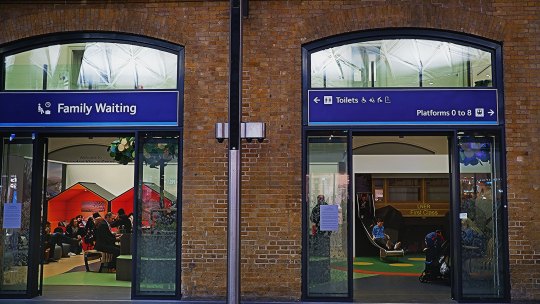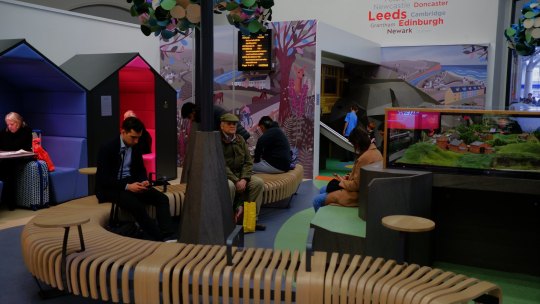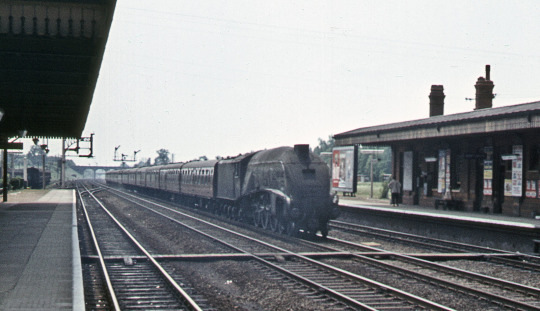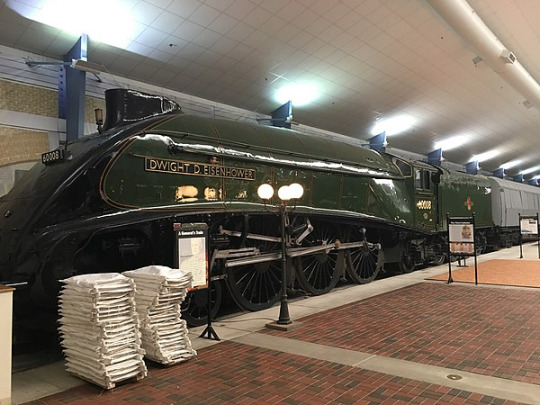#london and north eastern railway
Explore tagged Tumblr posts
Text


Just got a very nice D11/2!

I also took some pictures of it with my A5 (They're both GCR engines so I thought it was fitting)

They frens :)
#lner#lner a5#lner d11#gcr improved director#62683 Hobbie Elliott#model trains#model railways#british railways#london and north eastern railway#great central railway#scotland#scottish trains#little bit of lore: the d11/2's were modified for use in scotland#they were also given visual modifications to look more like the north british railway's engines#i like gcr engines theyre very pretty
11 notes
·
View notes
Text

Poster celebrating the LNER No. 4472 Flying Scotsman completing the London-Edinburgh trip in May 1928 without stopping.
4 notes
·
View notes
Text

this is my blorbo btw
#es1#ner es1#lner es1#north eastern railway#london and north eastern railway#ner#lner#london & north eastern railway#electric locomotive#electric train#steeplecab locomotive#blorbo#baconyposting
2 notes
·
View notes
Video
Class Y9 shunter 68123 in Dock Street, Dundee - Jul 1952 by Frederick McLean Via Flickr: One of a collection of 3" x 2" amateur transport photographs, all dating between 1947 and 1952. This one was taken on the 17 July 1952 and is of the LNER class Y9 0-4-0ST British Railways shunter 68123 working in Dock Street, Dundee. 68123 was designed/built by Neilson and Company of Hyde Park Works, Springburn, Glasgow, in Aug 1899, working from the 'Dundee Tay Bridge' shed. It was withdrawn Aug 1960 and scrapped at the BR Cowlairs Works. The photo reverse is annotated with "68123 shunting in Dock Street, Dundee, 17/7/52". Old/new side by side overhead maps view:- maps.nls.uk/geo/explore/side-by-side/#zoom=16.0&lat=5... If there are any errors in the above description please let me know. Thanks. 📷 Any photograph I post on Flickr is an original in my possession, nothing is ever copied/downloaded from another location. 📷 -------------------------------------------------
#old photograph#old transport#steam engine#steam train#Dundee dock railway#steam shunter#68123#Dundee#old Dundee#Dundee transport#vintage transport#vintage photograph#1950s#British Railways#LNER#Class Y9#London and North Eastern Railway#Dundee docks#Dock Street Dundee#flickr
2 notes
·
View notes
Text

Presenting Tornado The Young Iron! As she appears in the amazing series by @tornadoyoungiron
I'll be posting the full sheet of IRL Liveries later today, and the full livery list is still being worked on, but it was time Tornado got the chance to shine
#Hazel art#A1 Peppercron#LNER Peppercron A1 Pacific#Tornado#60163#Young Iron Au#London North Eastern Railway#British Railways#Pacific#New Build
31 notes
·
View notes
Text


introducing the big four. the main troublemakers. berwyn (GWR) is probably the only one who still has this photo.
ask box is now open as well !
#inbetweenthelines#ibttl4#lner#lms#southern railway#gwr#great western railway#london midland scottish railway#london north eastern railway#ttte#the railway series#railway series#personification#gijinka#thomas the tank engine#thomas and friends#railway#british rail#oc art#digital art
42 notes
·
View notes
Text

(if you get it you get it) 🦆
#Sir Nigel Gresley and his beloved Mallards#A4#LNER#LNER A4#locomotive#Mallard#Gresley#Sir Nigel Gresley#London North Eastern Railway#LNER A4 Pacifics#Sir Herbert Nigel Gresley#streaks#125.88 mph#Dwight D Eisenhower#Union of South Africa#Dominion Of Canada#Bittern#4468#4464#4489#4488#4496#4498#is it too late to make the aspect ratio the same as an A4???? someone#🦆#my edit
37 notes
·
View notes
Video
FS 025 meeting SB Flambeau '400' by Joseph Petric Via Flickr: Meeting the Flambeau '400' July 1970
#flambeau 400#lner 4472 flying scotsman#london & north eastern railway 4472 flying scotsman#cnw#chicago & north western#lner#london & north eastern railway#1970#chicago#green bay#trains#passenger train#history
37 notes
·
View notes
Text

Made a turn by King's Cross to have a look at their relatively new family waiting room on my trip to London last week. I was there mainly for the model railway, but the whole set-up is so brilliant I thought it really did warrant a bit more coverage.




Opening in 2022, the family waiting room features a variety of seating areas and a play area to keep children entertained while they wait for their train, and its design includes lots of references to the heritage of the East Coast Main Line, aiming to pique the interest of young travellers in the hope that it might bloom into a career in the rail industry. In all honesty, the thinking does seem a little cliche and almost politicised, but I still love the idea of a place where some thought is put into the experience of travel in an age when experience isn't nearly as frequently enough of a consideration as it should be. Raising a family can be challenging, and travelling with one even more so, so if we want to encourage families to travel at all, let alone by public transport, then putting the effort into creating places where children can be engaged and occupied during periods of waiting can go a long way to help.

#King's Cross#public transport#East Coast Main Line#National Rail#railway station#model train#heritage#LNER#history#British Railways#steam train#urban design#transport planning#family friendly#Flying Scotsman#Mallard#LNER Azuma#class 91#London#King's Cross Station#family waiting room#careers#rail industry#family area#passenger experience#London & North Eastern Railway#LNER 4468 Mallard#LNER 4472 Flying Scotsman#Azuma#Intercity Express Train
2 notes
·
View notes
Text


Take a nice, long look at LNER A1 Pacific Flying Scotsman in their first version and the VR S-Class Pacific S300 (later to be named Matthew Flinders) pre-streamlining (built in 1928, designed by Alfred E. Smith).
Very similar, huh?
The overall form is quite similar, even down to the little dip in the running plate. The S-class Pacifics had a pure Gresley conjugated valve gear between the two Walschearts cylinders as well.
#Victorian Railways#London & North Eastern Railways#LNER#VR#LNER A1/A3 Pacifics#VR S-Class Pacifics#real locomotives#real life railways#real trains
4 notes
·
View notes
Text

LNER Azuma
#phoneography#mobiele telefoon fotografie#mobile phone photography#smartphoneography#smartphone fotografie#smartphone photography#travel#travel photography#reizen#reisfotografie#reisen#voyage#viajar#LNER#London North Eastern Railway#Azuma#London#Doncaster#intercity#railway#spoor#Bahn#railways#British#Britain#Geeat Britain#United Kingdom#UK#GB#Europe
3 notes
·
View notes
Text
Byrne can resurrect Mallard and run her on the mainline, as a treat

Defender of the fastest locomotive from that usurper 5550.

u.u
117 notes
·
View notes
Video
RPPC of Great Central Railway loco No. 969 @ Trafford Park by Frederick McLean Via Flickr: An old RPPC of Great Central Railway (GCR) steam locomotive No. 969 outside Trafford Park engine/locomotive shed (13A). This real photo postcard was produced by 'F. Moore's Railway Photographs' of London, in the very early 1900s. It is annotated with "outside Trafford Park shed". No. 969 was a X4 class 4-2-2 engine, built in the Gorton Works, and new to GCR in Aug 1900. In 1923 the existing railway companies were grouped into 'the big four', the GCR becoming part of the London and North Eastern Railway (LNER) who renumbered the engine as 5969 in Aug 1924. The locomotive was withdrawn from service in Jul 1926, then scrapped back at the Gorton Works. Old/new overhead maps view of shed and sidings:- maps.nls.uk/geo/explore/side-by-side/#zoom=16.0&lat=5... If there are any errors in the above description please let me know. Thanks. 📷 Any photograph I post on Flickr is an original in my possession, nothing is ever copied/downloaded from another location. 📷 -------------------------------------------------
#Great Central Railway#postcard#old postcard#photo postcard#vintage postcard#railway#steam engine#steam train#steam locomotive#steam loco#locomotive#loco#old steam engine#Trafford Park shed#Trafford Park#engine shed#locomotive shed#X4 class#London and North Eastern Railway#LNER#GCR#4-2-2#Gorton Works#flickr
0 notes
Note

What are they doing?
They're express engines. They're discussing the state of the railway (gossiping)
but fun thing, there are only 4 A4s here
far right isn't an A4, it's Hush Hush

yep, the LNER's rebuilt white elephant. By all acounts I've found, post rebuild she was just a non-standard A4. Although it is worth noting Gresley was considing rebuild the A4s with the boiler fit to no.10000, so he was impressed with that at part of the rebuild at least.
heading left, we have Golden Eagle

Empire of India (my beloved)

Golden Shuttle, who was later renamed Dwight D. Eisenhower and Preserved

and Dominion of New Zealand

#Hazel Asks#Ask Hazel#Hazel Q&A#LNER#London North Eastern Railway#LNER A4#LNER W1#4-6-2#4-6-4#A4 Pacific
36 notes
·
View notes
Text
Christmas Story



The letters continued...
Threats were issued:
“He’s dead if I ever see him.”
“-and if he ever shows his face around my shed, he’s a dead engine.”
“HIS COMPONENT PARTS WILL REGRET BEING ATTACHED TO HIM.”
“I’ll show him exactly what kind of a terror us diesels can be.”
“Personally, I’d have introduced his teeth to his superheater…”
-
And welcomes were given.
“I suppose this makes you one of ours now.”
“It’s nice to increase the ranks for once.”
“Can we keep you and trade Mallard to the Western?”
“I, for one, welcome you with smooth rails and green signals.”
“-and don’t worry! You’ll fit in just fine!”
-
Forgiveness was given, despite not being asked for.
“We have heard about your recent change in “livery” and we understand.”
“Considering what’s happened I don’t blame you for tossing us into the bin.”
“-I’ve heard talk that some engines are quite taken with what you’ve done. Might be a trend!”
“Usually, old allegiances die hard. In your case, I’m surprised it lasted as long as it did.”
“Perhaps some day we can dispense with the old rivalries altogether…”
“YOU DESERVE BETTER THAN US.”
-
And declarations were made.
“ - you will always be one of us, and we love you.”
“I can’t wait to see you at the next gala!”
“YOU’LL LOOK GOOD IN BLUE, I GUARANTEE IT.”
“Keep us in your memories, but go wherever your heart takes you.”
“Don’t let engines like him keep you in a bad place, okay?”
-
Then there were the signatures.
Your Brother
Your Sister
Your Friend
Your Compatriot
YOUR FELLOW WESTERNER
Your Eastern Acquaintance,
Caerphilly Castle
Evening Star
Deltic
Flying Scotsman
King George V
PENDENNIS CASTLE
№1306 Mayflower
D7017
D7018
D7026
D7076
Western Prince
Black Prince (92203)
Mallard [Who is writing this under duress]
Aerolite
26000 (Tommy)
№ 1420
D9500 & D9531
Lode Star
Green Arrow
№ 4498 Sir Nigel Gresley
The Engines of the Vale of Rheidol Railway
D821, D818, and D832
Blue Peter
55 022 (Royal Scots Grey)
Tuylar
Dominion of Canada
Dwight D. Eisenhower
Bittern
92212
Western Ranger
55 016
№4588
Alycidon (D9009)
№ 65462
Western Champion
Bradley Manor
7819 Hinton Manor
D9002
Royal Highland Fusilier (D9019)
№ 6412
Clun Castle
6990 Witherslack Hall
Sir Hadyn and Edward Thomas
№ 18000 (Kerosene Castle)
4488 (Union of South Africa)
Morayshire
Olton Hall
Hagley Hall
55 021
King Edward I
King Edward II
Western Courier
Western Lady
D9534
№ 7293
Western Campaigner
----------------------
Then they opened the boxes.
The small ones were addressed to Duck and Oliver. The first few were opened up, revealing, “Name plates? Why name plates?”
“Well, hang on a minute, these don’t look like any name plates I’ve seen before.”
“Ah, wait, that’s it. They’re usually curved, to go over the splashers.”
“And they’re not red.”
“Well, they are if… ooooh.”
“What?”
“They’re Eastern. With the red backing. These’re LNER plates.”
Oliver stared at Duck, ignoring how the men were opening up a separate box with a similar return address.
“It’s a builder’s plate?!”
“It’s an LNER builder’s plate, see the shape?”
“Forget the shape, it says London and North Eastern on it.”
“Oh gosh, this is serious, innit?”
“That’s borderline sacreligious is what it is. Lookit that! It says Swindon on it!”
“Gordon is going to be insufferable about this, I just don’t know how.”
-
There was an identical plate for Duck, and… glory be, it really was an LNER-styled builder’s plate, made out with his information. They even found out his original works number.
He breathed in deeply. In through the nose, out through the mouth. He mattered to them, in a way that felt just as, if not more personal than the pile of letters on the floor. Maybe it was the shock, the lingering feelings from hearing Truro’s unhinged rant in the cold December air.
“I think,” he looked between the plate, and Oliver. “That we’re at a moment in our lives that we can’t go back from.”
-----------
The boxes addressed to Bear were much larger, and were in greater quantities.
“Oh look, this one’s a headboard!” exclaimed his driver.
Bear’s eyes nearly popped out of their sockets when he saw that it said THE FLYING SCOTSMAN on it.
The note attached was short, but sweet. “‘Tis nice to have another Eastern Diesel. Mayhaps someday this shall be used again in anger.” It was signed “Royal Scots Grey”.
-
The next one had the GWR crest burned into the surface of the crate. Opening it revealed a rather lengthy nameplate wrapped in cloth. A note was tied around it.
“Dearest Bear,” it read. “He’s done, even if he doesn’t know it yet. This raises an issue - we do need a “City” in our ranks. We think you can take up that role.”
The wrapping was undone, and Bear could feel a shocked tear build up in his eye.
The words CITY OF TIDMOUTH glinted in the lights of the shed, the letters done in shining brass, just like the steam engines of old.
-
Another package, this one from an address that he vaguely remembered as being an old Eastern Region TMD, contained a host of plates both large and small. The largest of them was a bright red rectangle, with silver letters that read BEAR. After looking it over, his crew deemed it to be a dead ringer for the name boards on Eastern Region diesels.
“Which means…” said his driver, rifling through the smaller plates, each the size of a medallion. “That these must be from all the different Depots. Yeah, yeah, look. This one’s Stratford, and here’s York. Blimey, I didn’t know that anyone had a Colchester one.”
This went on for several minutes, as plates from seemingly every Eastern Region TMD were removed from the box. Bear’s eyebrows rose until they could go no higher.
-
The next morning, his crew busied themselves with attaching several of the plates to his sides. There was some argument as to where they should be placed, and how to avoid making Bear look like “he was covered in fridge magnets.”
Said argument was still ongoing as Gordon rolled by. His suddenly-wide eyes went from the Eastern Region name plate to THE FLYING SCOTSMAN headboard in shock.
Bear ignored his crew, who were intently measuring the “CITY OF TIDMOUTH” nameplate like it may suddenly change size, and fixed Gordon with an intent look. “This is unequivocally your fault,” he said, keeping his tone serious even as he started to smile. “Thank you.”
----------
A few days later, as the mail started to peter off, a deeply overstuffed document mailer ended up at the shed in Arlesburgh, addressed to Oliver and Duck collectively.
It was a long and dry letter, filled with passages about duty and honor, dictated by King George V, the “self-proclaimed pro tempore leader of our kind, now that Truro is out.”
Naturally, Duck found it fascinating, while Oliver would rather gnaw off his own buffers. It grew so dull that eventually the stationmaster got bored of reading Duck’s copy of the pair of identical letters aloud, and fetched a sheet music stand from the station, placing the type-written pages across it for the two engines to read at their own pace before leaving for the station.
Oliver’s pace was “no, thank you, but I’d really rather skip to the end,” but Duck was insistent on reading the entire letter aloud.
“-I humbly ask you as a fellow Westerner, free of all but our Swindon metal, do you have any interest…” Duck abruptly trailed off.
“Hm?” Oliver said, blinking himself to attention. “Interest in what? Don’t tell me you’ve gotten bored now?”
Duck ignored him. “They can’t really-”
“Really what? Out with it!”
“Look!” Duck yelped. “It’s right there, on the fifth page, towards the bottom.”
Oliver rolled his eyes, but eventually found the sentence. “-any interest in becoming the new figurehead of the Great Western? What?” He squeaked in surprise, eyes skimming the preceding paragraphs to see what in the world they were on about.
“-perhaps the most unfortunate part of Truro’s fall from grace is that he is - or perhaps was - the most recognizable member of our lineage by a wide margin. While it remains true that the enthusiast may recognize myself or Caerphilly, the general public likely knows Truro for the same reason that they know Flying Scotsman. The name Great Western, and what it stands for, is vestigial at best.
That being said, a new opportunity has presented itself. As I am sure you are aware, the books by the Reverend Awdry featuring you and Oliver have spawned a television show, which has in turn re-ignited popularity in the books. Already I have had to field queries about your Island from children clutching copies of “Duck and the Diesel Engine.” Many who have no other knowledge of our ways have nonetheless made the connection that we Westerners all know each other, and have asked me about you and Oliver. Strangely, none have asked about Truro; in fact, one child, who I have been assured does not yet know how to read, mistook me for Truro, and asked me what visiting Sodor was like. (I did not dissuade him of this view. I hope that I was correct in my assumption that Sodor is very pleasant in the summer.)
I’m sure that you can see the common thread here. You and Oliver will have an uncommon familiarity with the next generation, and possibly many more beyond. While I, Caerphilly, and the rest sit quietly behind ropes, you will continue as a working engine, adding to our common lore, and preaching our gospel. You are the highest ranking Paddie Shunter to survive the purges of Modernization, and you know more of Our Ways than even I do.
With this in mind - and please do not take this as an obligation, a chore, a weight against your buffers - I humbly ask you as a fellow Westerner, free of all but our Swindon metal, do you have any interest in becoming the new figurehead of the Great Western Railway?”
--
Neither engine got any sleep that night, and it was a very bleary Duck that took the first train into Tidmouth the next day.
“You look terrible,” Gordon sniffed unthinkingly. “Do you not sleep at night? Too much rearranging of your goods yard, perhaps?”
“Gordon, please-”
On the road opposite Duck, Bear raised an eyebrow. “It’s too early in the morning for either of you to start.”
“Oh fine,” Gordon huffed as the last of the passengers flooded into the express. “But it’s rather undignified for an Easterner to be so disheveled. Just look at us for an example, Duck!”
Point made, he set off with a whoosh of steam, and within a minute the train’s rear lamp was fading into the distance.
Bear didn’t say anything for a long while. Duck wondered if the diesel wasn’t saying anything because Gordon was right - compared to Bear’s mirror-shine paint and Gordon’s polished brass, he looked awful.
Or, the vicious little voice in the back of his mind piped up. He still doesn’t want to talk to you. Considering how you sided with Truro over-
“So, I got a letter yesterday.” Bear said, apropos of nothing. “From King George V herself.”
“Oh?” Duck seized the chance to get out of his own mind. “What about?”
“Seems like the Great Western needs a new figurehead, considering that somebody has lost all his prestige.”
“O-oh…” Duck warbled. “You got that too?”
“Mmhmm.” Bear wasn’t looking at anything in particular. “Apparently the television show is driving people to the books; people seem to like conflict in their children’s books. Something about being able to show right from wrong.”
“Do they now?” Oh, if only the rails could swallow him whole at this moment.
“Oh yes.” Bear looked contemplative. “It also helps that nobody really likes diesels. Smelly, underhanded things. It’s quite nice to be able to have one cause trouble and then get sent away for doing that in one single book.”
“Yes, I-I’m quite aware of what happened…” Maybe his boiler could explode. That might fix things.
“And everybody loves a runaway train.”
“Well, I -uh, I wouldn’t- um…”
Bear smirked. “Obviously I don’t include you in that.”
“W-w-well of course, I-”
Bear didn’t say anything for a second, and Duck continued to trip over his own tongue, until:
“She’s right, you know.”
“Wh-what?”
“King George. She’s right about you. Every child in the country is going to know your name someday, especially if they put you on the telly. And there’s not another engine alive who knows all of the history that you do.”
“Bear,” Duck finally managed to find his voice. “I can’t.”
“Why not?”
“Why not?” Duck was floored. “Bear, you were there! I just followed along behind him, doing whatever he said to-”
“Duck,” Bear cut him off and looked him straight in the eyes. “He was City of Truro. Who would have expected that out of any engine, let alone one of his stature?”
“But - but - but I-”
“Acted childish, perhaps,” Bear continued, gently. “But he revealed himself to you at the same time he did everyone. Even I didn’t think he’d hurt me on purpose!”
“But I should have noticed!” Duck cried. “And I didn’t! What sort of leader would I be?”
Bear was unmoved. “It’s true that you didn’t notice then, but look at what you’re doing right now.”
“What?”
Bear smiled gently, his new nameplates gleaming in the station lights. “You’re giving yourself the third degree over this. It’s been six months, Duck! Even I’ve moved on from that, or I would, if you’d let me. Truro’s got his just desserts, I’ve found that more engines care about me than I previously thought possible, and Oliver… is Oliver-ing along like nothing ever happened. It’s just you who hasn’t moved on from this yet, and that is the true mark of a leader.”
“No, Bear,” Duck started to stammer. “But-I can’t. Surely-”
“The only sure thing is that you’d do a good job.” Bear said as the last of his passengers boarded. “Besides, if you do badly enough…” The guard blew the whistle, and waved the green flag. “You’ll look really good in garter blue!”
And then he was off, engine roaring. The train sparkled against the early summer sun as it left, and Duck was suddenly alone at the platform.
“He does make a good point,” Well, he was almost alone. He was still coupled to Alice and Mirabel. “What do you want to do?”
Duck didn’t say anything for a long while.
He had a lot to think about.
34 notes
·
View notes
